

This week was the 10th Anniversary of The English Apple Man website.
The first English Apple Man Journal went on-line on 14th August 2009
Click on The English Apple Man Journal for 14th August 2009
This week The English Apple Man joined fellow members of East Kent Fruit Society (EKFS) for the 2019 EKFS winning orchard walk held on Tuesday 13th August at W&D Riccini's 'Oast House Farm' in Stourmouth in East Kent.
Always an enjoyable evening, and we were so lucky with the weather; 'wet on Monday' - 'dry on 'Tuesday' and 'wet again on Wednesday'
Below: left; The entrance to Oast House Farm and right; David & Will Riccini
Below: Will Riccini welcomes EKFS members to Oast House Farm and delivers an overview of the Riccini brothers business
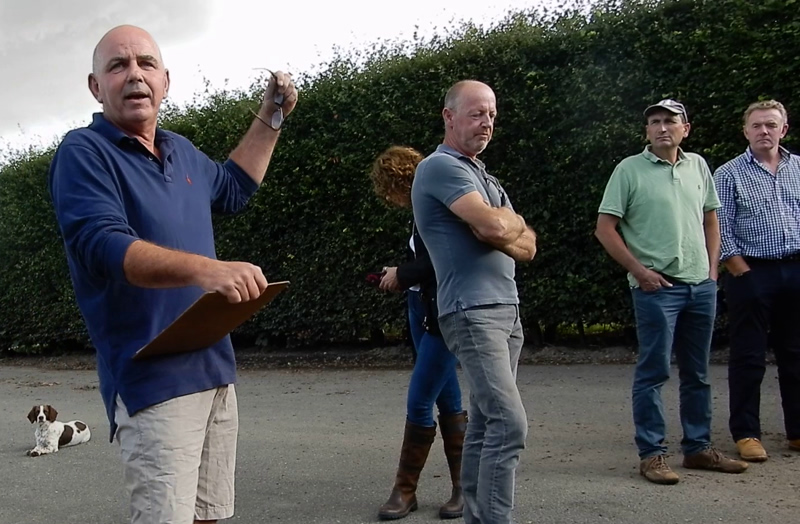
Will and David farm about 210 acres on four sites - here at Stourtmouth, a second farm at Bekesbourne, a third at Staple and the latest at Harbledown. We grow mainly Gala, Braeburn and Conference pears. Will said; "We also grow about 60 bins of Cox apples (mainly planted as pollinators) and we have just planted Cameo.
Cropping: 3200-3400 bins of Gala - Braeburn 2200 bins, Conference 800 bins, Cox 60 bins and Worcester Pearmain 400 bins (their last year before grubbing)
Heavily into planting more Gala; Gala One planted at the new farm at Harbledown, hoping to give us another 5 days of Gala picking - 'Gala One' is claimed to pick 5-7 days earlier than other Gala clones.
Will said: "we also have 15 acres of Cherries under tunnels.
Labour: "We started this season with 22 seasonal workers in June - we start with thinning Gala. We thin down to 'doubles' and then come back in August (after Cherries) and 'quality thin' ensuring all fruit is at least 50mm, working on the growth curve expectation that the smallest fruit will reach 60mm by harvest in mid September.
We only have one full time worker + ourselves. We top up at the beginning of September with another 30 pickers going right through until the end of October.
Marketing: "We sell everything through AC Goatham and we are members of Mid Kent Grower Producer Organisation (PO) - new planting is either Gala One or Royal Beaut. Braeburn is either Hillwell or Mariri Red.
Below: left; Braeburn apples and right; Braeburn Hillwell rows
Below: Will Riccini demonstrates which (stronger) branches will be removed in Winter.
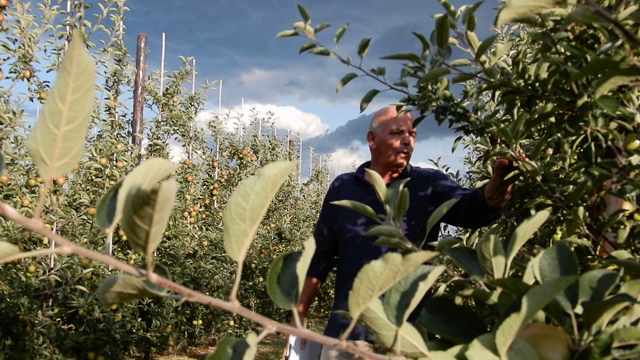
"This Braeburn is now in it's third leaf (2nd crop) and the trees which came from Italy were enormous. In it's 2nd leaf 1st crop it produced 39.1 tonnes per hectare. Will said: regarding pruning, we try not to do too much in the first 3-4 years, trying to get them into cropping; we take out one or two larger branches at source (back to the trunk) and try to settle the tree into weaker lateral/cropping wood. Planting distance 3.5 metre x 1 metre.
"We put a lot of Calcium Nitrate on to build up the bud for next year; on FAST advice we did this immediately after harvest, but we now believe it needs to go on earlier to deliver the best results, so we apply it in September. We believe it helps overcome biennial cropping".
Below: left; Gala Royal Beaut. orchard and right; Gala Royal Beaut. apples
This Gala Royal Beaut. orchard is now 8 years old. Cropping at 45-50 tonnes per hectare.
Below: More than 50 EKFS members attended the farm walk at Oast House Farm
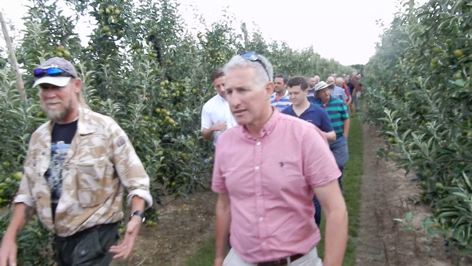
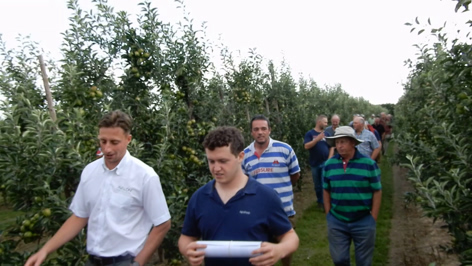
Thinning.
Getting thinning just right is always tricky and Will told the group their strategy in this Gala orchard was to thin all bunches down to two fruits, which was carried out when the fruitlets were still small (finger nail size). He and David debated the use of Brevis (a thinning spray) but Will admitted he thought it unnecessary.
BREVIS was developed by the research team at the Fruit Research Station in Jork (DE) with the aim to replicate the known effects of shade thinning on apple and pear trees. BREVIS combines a photosynthesis inhibitor and a commonly used fertilizer (Calcium formate). Initial results were very encouraging and confirmed BREVIS as the most effective Carbaryl substitute among all other thinning candidates.
BREVIS was developed in collaboration with leading experts on fruit thinning in and outside Europe. Since the development started in 2008, more than 500 trials were conducted worldwide to assess the performance of BREVIS under a wide range of varieties and growing conditions. BREVIS is being registered for use in apple and pear orchards in all relevant pome fruit countries; with rates from 1.1 to 2.2 kg/ha and a maximum of 2 applications per season. Recommended timing of application is between 8 and 16 mm fruitlet size. If 2 applications are needed the recommended timing of 1st application should be at 8-10 mm fruit diameter stages; and 2nd at 12-14 mm.
During Cherry picking David told Will "we need to do more hand thinning" - as a result a second hand thinning took place and the cost of the aggregated thinning reached £1,000 per acre!!!!
Will explained: Initially we spent 55p a tree to thin to doubles in early June - the second thinning in early August has cost another 55p per tree.
Below: left; Will discusses thinning on this Gala orchard and right; fruit discarded in the 2nd thinning operation in August
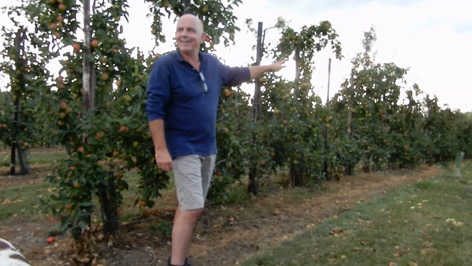
The EKFS Orchard of the year 2019 - Breaburn Hillwell - planting distance 1.25 m x 3.5 m
EKFS Orchard of the Year - Prize Elgar Memorial Bowl - W and D Riccini - OH6
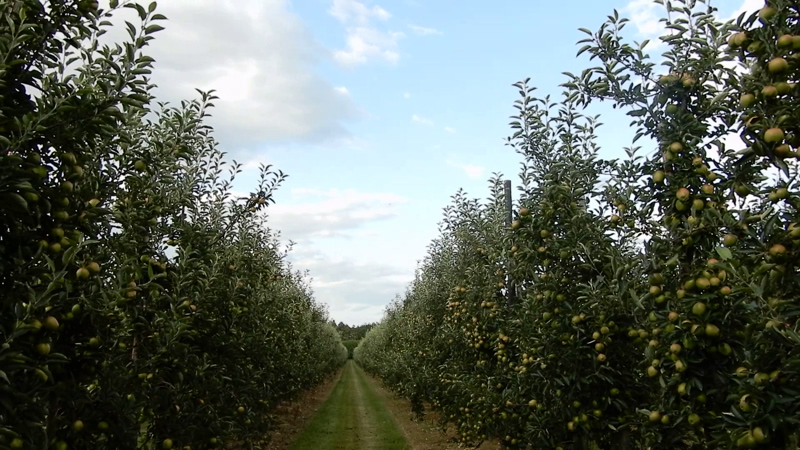
This winning Braeburn orchard was planted in 2007 and covers 1.81 hectares. It has cropped at 60-70 tonnes per hectare over the last 6 years and Will expects in excess of 70 tonnes and possibly as much as 80 tonnes this year.
Below: Will demonstrates a simple removal of one year wood with small apples on the end by shortening the lateral branch by breaking a section at the end removing the smaller apples @ a cost of just £80 acre
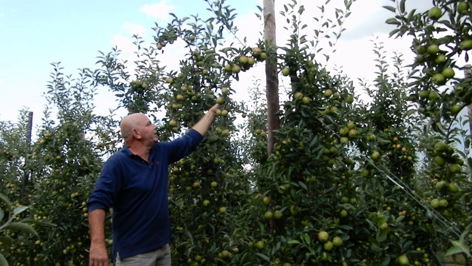
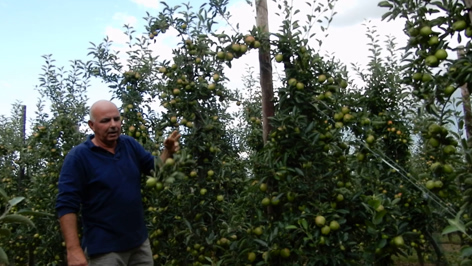
Below: Will breaks the end of a branch removing the smaller apples and dropping the section to the ground
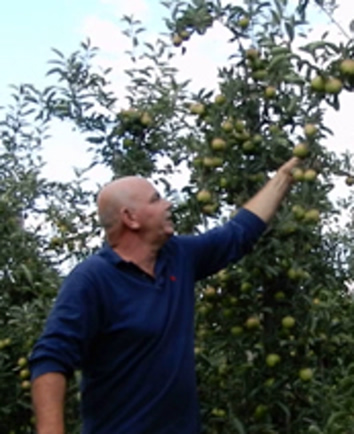
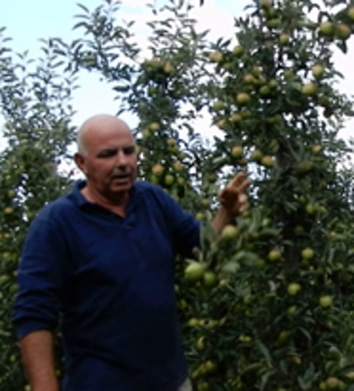
Below: Across the road and a new Cameo orchard planted in April 2019 and in it's first leaf.
Will said: "We planted Cameo not only because it is a good apple with good flavour, but also as it fits nicely between Gala and Braeburn in the picking window" - The planting distance is 3.5m x 1m .
EKFS Chair - Caroline Ashdown summarises the Orchard Competition and welcomes Gala Club as an integral part of EKFS
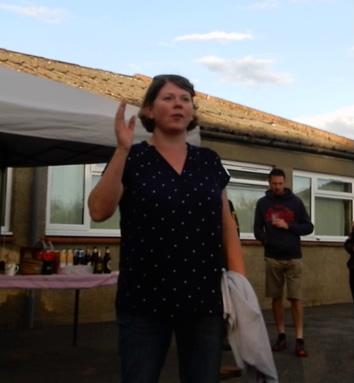 Caroline Ashdown reminded members that the Gala Club has merged with the East Kent Fruit Society and in recognition of previous Gala Club pre-harvest meetings, Caroline thought it appropriate to have two speakers to udate harvest date and storage issues and forecasts for Gala this season.
Caroline Ashdown reminded members that the Gala Club has merged with the East Kent Fruit Society and in recognition of previous Gala Club pre-harvest meetings, Caroline thought it appropriate to have two speakers to udate harvest date and storage issues and forecasts for Gala this season.
Below: Mark Tully of Landseer informing EKFS members about storage updates
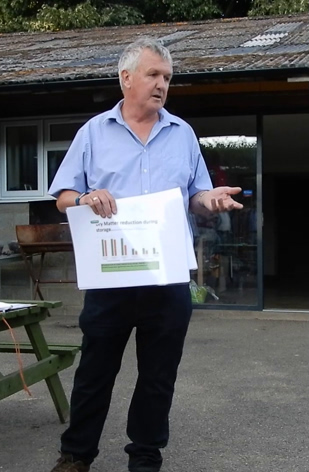 Mark Tully said: "one of the most interesting things we did this season was organise a taste test on the 1st July tasting English Gala and imported Southern Hemisphere Gala.
Mark Tully said: "one of the most interesting things we did this season was organise a taste test on the 1st July tasting English Gala and imported Southern Hemisphere Gala.
The comparison found home grown Gala delivered a better taste score than the Southern Hemisphere (new season fruit) - the reason is the best fruit had high dry matter which ensures the fruit has ample sugars and acids meaning the apple has good reserves to carry it long term and still deliver a great eating experience.
Moving onto predicting harvest dates: Mark said we (Landseer) will be doing the chlorophyll fluorescence tests and this will give a 7day warning of when starch levels drop to 80% in apples.
Below: Sarah Calcutt - Operations Director of British Apple & Pears Association up dates members on the global apple crop
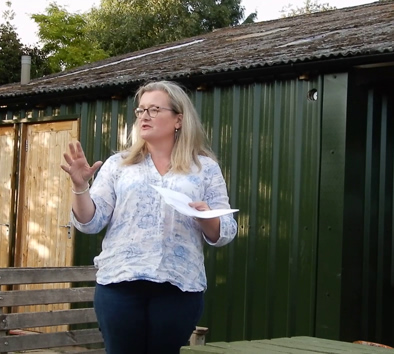 Sarah Calcutt reviewed the crop forecasting from this year's PROGNOST Fruit Conference.
Sarah Calcutt reviewed the crop forecasting from this year's PROGNOST Fruit Conference.
PROGNOSFRUIT is the world's leading annual event for the fruit industry. At this conference, the World Apple and Pear Association (WAPA) announces the apple and pear production forecast, and fruit market trends in the EU and outside are discussed. The conference brings together producers, processors and traders from various European countries and beyond.
One very interesting fact is the high levels of sun scorch reported on many top fruit growing countries. Temperatures in excess of 40 degrees Celsius have been prevalent across EEC counties and beyond.
Last year in Europe the large crop resulted in many growers losing money, in fact many are near to going out of business. The European crop this year is estimated at 10.5 million tonnes and Poland (the largest producer in Europe and the 3rd largest apple producer in the World, is predicted to have a crop of only 50% of 2018.
USA has it's largest crop ever, but cannot pick it all due to labour shortages.
On the home front, Sarah said: English Apples & Pears (EAP) has now been changed to 'British Apples & Pears Association' - BAPA
Finally, a survey initiated by John Breach Chairman of BIFGA demonstrates the imbalance of cost v return for the grower v retailer!
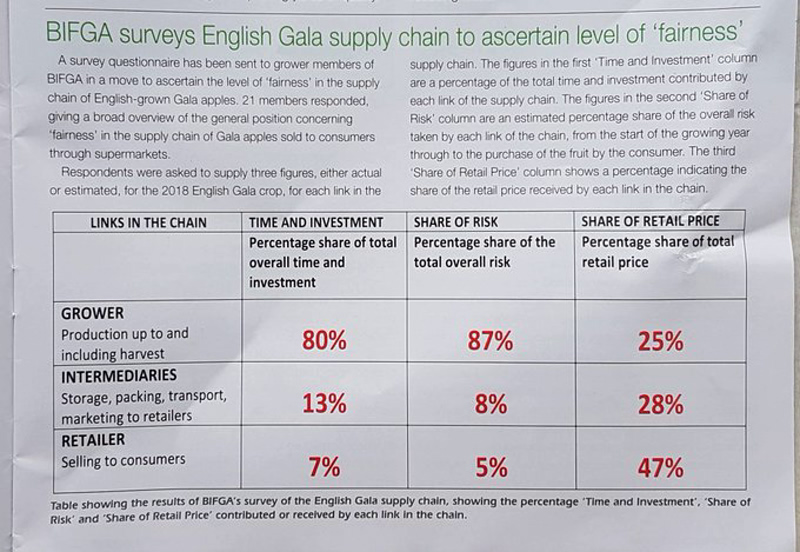
That is all until next week
Take care
The English Apple Man